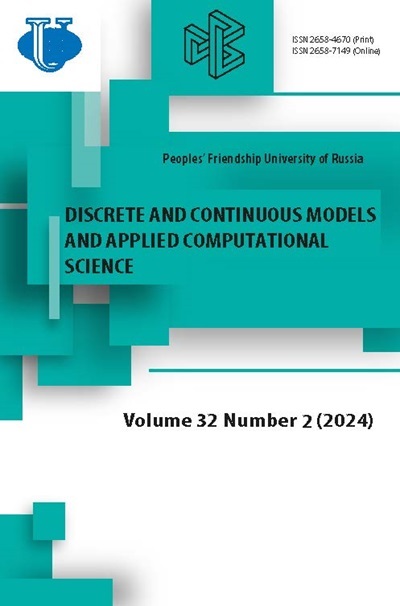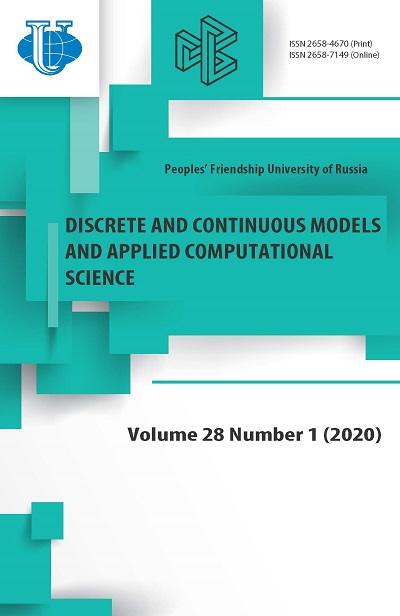Численное определение порядка особенности системы дифференциальных уравнений
- Авторы: Баддур А.1, Малых М.Д.1, Панин А.А.2, Севастьянов Л.А.1
-
Учреждения:
- Российский университет дружбы народов
- Московский государственный университет им. М. В. Ломоносова
- Выпуск: Том 28, № 1 (2020)
- Страницы: 17-34
- Раздел: Математическое моделирование
- URL: https://journals.rudn.ru/miph/article/view/23694
- DOI: https://doi.org/10.22363/2658-4670-2020-28-1-17-34
Цитировать
Полный текст
Аннотация
В статье рассматриваются подвижные особые точки систем обыкновенных дифференциальных уравнений. Дан обзор результатов Пенлеве об алгебраичности этих точек и их связи с задачей Г. И. Марчука об определении положения и порядка подвижных особых точек по методу конечных разностей. Представлена реализация численного метода решения этой задачи, предложенная Н. Н. Калиткиным и Е. А. Альшиной (2005) на основе комплексной схемы Розенброка, в системе компьютерной алгебры Sage - пакет CROS for Sage. Описаны основные функции этого пакета, приведены численные примеры использования каждой из них. В целях верификации метода проведены компьютерные эксперименты: (1) с уравнениями, обладающими свойством Пенлеве, для которых порядки должны получаться целыми числами; (2) с динамической системой Калоджеро. Эта система, хорошо известная как нетривиальный пример вполне интегрируемой гамильтоновой системы, в данном контексте интересна тем, что координаты и импульсы являются алгебраическими функциями времени, причём порядки подвижных точек ветвления можно вычислить явно. В рамках численных экспериментов обнаружено, что условия применимости метода требуют дополнительных оговорок, связанных с исключением точек суперсходимости.
Ключевые слова
Об авторах
Али Баддур
Российский университет дружбы народов
Автор, ответственный за переписку.
Email: alibddour@gmail.com
Кафедра прикладной информатики и теории вероятностей
ул. Миклухо-Маклая, д. 6, Москва, 117198, РоссияМихаил Дмитриевич Малых
Российский университет дружбы народов
Email: malykhmd-md@rudn.ru
доктор физико-математических наук, доцент кафедры прикладной информатики и теории вероятностей
ул. Миклухо-Маклая, д. 6, Москва, 117198, РоссияАлександр Анатольевич Панин
Московский государственный университет им. М. В. Ломоносова
Email: a-panin@yandex.ru
Кафедра математики физического факультета
Ленинские горы, Москва, 119991, РоссияЛеонид Антонович Севастьянов
Российский университет дружбы народов
Email: sevastianov-la@rudn.ru
доктор физико-математических наук, профессор, профессор кафедры прикладной информатики и теории вероятностей
ул. Миклухо-Маклая, д. 6, Москва, 117198, РоссияСписок литературы
- W. A. Stein, Sage Mathematics Software (Version 6.7), The Sage Development Team, 2015.
- W. W. Golubev, Vorlesungen über Differentialgleichungen im Komplexen. Berlin: VEB Deutscher Verlag der Wissenschaften, 1958.
- P. Painlevé, “Leçons sur la theorie analytique des equations differentielles,” in Œuvres de Paul Painlevé. 1973, vol. 1.
- C. L. Siegel and J. Moser, Lectures on Celestial Mechanics. Springer, 1995.
- E. A. Al’shina, N. N. Kalitkin, and P. V. Koryakin, “Diagnostics of singularities of exact solutions in computations with error control,” Computational Mathematics and Mathematical Physics, vol. 45, no. 10, pp. 1769-1779, 2005.
- A. A. Belov, “Numerical detection and study of singularities in solutions of differential equations,” Doklady Mathematics, vol. 93, no. 3, pp. 334- 338, 2016. doi: 10.1134/S1064562416020010.
- A. A. Belov, “Numerical diagnostics of solution blowup in differential equations,” Computational Mathematics and Mathematical Physics, vol. 57, no. 1, pp. 122-132, 2017. doi: 10.31857/S004446690002533-7.
- M. O. Korpusov, D. V. Lukyanenko, A. A. Panin, and E. V. Yushkov, “Blow-up for one Sobolev problem: theoretical approach and numerical analysis,” Journal of Mathematical Analysis and Applications, vol. 442, no. 2, pp. 451-468, 2016. doi: 10.26089/NumMet.v20r328.
- M. O. Korpusov, D. V. Lukyanenko, A. A. Panin, and E. V. Yushkov, “Blow-up phenomena in the model of a space charge stratification in semiconductors: analytical and numerical analysis,” Mathematical Methods in the Applied Sciences, vol. 40, no. 7, pp. 2336-2346, 2017. doi: 10.1002/mma.4142.
- M. O. Korpusov and D. V. Lukyanenko, “Instantaneous blow-up versus local solvability for one problem of propagation of nonlinear waves in semiconductors,” Journal of Mathematical Analysis and Applications, vol. 459, no. 1, pp. 159-181, 2018. doi: 10.1016/j.jmaa.2017.10.062.
- M. O. Korpusov, D. V. Lukyanenko, A. A. Panin, and G. I. Shlyapugin, “On the blow-up phenomena for a one-dimensional equation of ion-sound waves in a plasma: analytical and numerical investigation,” Mathematical Methods in the Applied Sciences, vol. 41, no. 8, pp. 2906-2929, 2018. doi: 10.1002/mma.4142.
- A. Baddour and M. D. Malykh. (2019). Cros for sage, RUDN, [Online]. Available: https://malykhmd.neocities.org.
- H. Airault, “Rational solutions of Painlevé equations,” Stud. Appl. Math., vol. 61, no. 1, pp. 31-53, 1979. doi: 10.1002/sapm197961131.
- (2019). Nist digital library of mathematical functions. version 1.0.25, The National Institute of Standards and Technology, [Online]. Available: http://dlmf.nist.gov.
- J. Moser, Integrable Hamiltonian Systems and Spectral Theory. Edizioni della Normale, 1983.
















